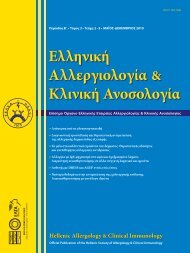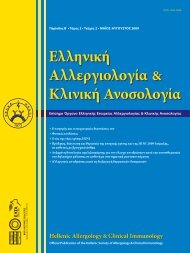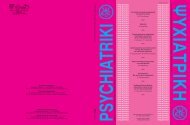INSTRUCTIONS TO AUTHORSHellenic Journal of Atherosclerosis 2(1) 73The journal HELENIC JOURNAL OF ATHEROSCLEROSIS, edited by the HellenicSociety of Atherosclerosis, aims at the continuous education of scientistsof various disciplines including Medical doctors, Biologists, Biochemists,Dieticians, etc in various topics related to the pathogenesis, diagnosis andtreatment of atherosclerosis. To this purpose it is looking to promote scientificpapers on the following sections:1. Editorials. Brief review articles on current and/or ambiguous topics relatedto Atherosclerosis and cardiovascular disease without abstract, writtenafter invitation of the Editorial Board. Three key-words should be listed.2. Reviews. Detailed surveys of medical subjects with the emphasis oncurrent points of view related to atherosclerosis and cardiovascular disease.3. Original papers. Reports on clinical trials or experimental work andepidemiological prospective or retrospective research in topics related toatherosclerosis, based on a research protocol described in detail in the methodologysection. The results of the study should not have been previouslypublished (except in abstract form). Clinical and epidemiological studieswith particular interest to Greek healthcare workers will be given priority.Quite exceptionally original papers published in distinguished foreignjournals by Greek scientists especially when their results are relevant forthe Greek medical community can be republished in HELLENIC JOURNAL OFATHEROSCLEROSIS after been approved by the Editorial Board. These papersmust be translated by the authors, who also have to obtain written permissionby the copyright owners.4. Clinical points of view. A diagnostic, therapeutic or epidemiologicalapproach to several clinical syndromes of the atherosclerotic disease; thedata for and against should be in algorithmic form.5. Case reports. Reports on new or very rare clinical cases of atheroscleroticdisease, new diagnostic criteria or new therapeutic methods withproven results.6. Conferences, seminars, round tables. Abstracts or short texts ofspeakers participated in conferences, seminars or round tables related toatherosclerosis organized by, or been under, the auspices of the HellenicAtherosclerosis Society or abstracts presented as posters in conferences organizedby the Hellenic Atherosclerosis Society.7. Book presentations. They should refer to the title of the book, theauthors’ name(s), the number of pages, the name of the publisher, the dateand the place of publication and the price.8. Correspondence. Letters containing comments on papers publishedin the journal, preliminary results, remarks about untoward effects of drugs,judgments concerning the journal etc. They must be signed.Previous or duplicate publication. Papers submitted to HELLENICJOURNAL OF ATHEROSCLEROSIS are judged for publication on the conditionthat the results or the paper itself have not been previously published or submittedfor publication in another journal. The corresponding author shouldreport in the cover letter that the research work has not been published orsubmitted for publication in an other journal. An exception to this rule is thefinal research results that have been published as preliminary results or asan abstract form. In this case, the author(s) should also submit electronicallythese previous publications in a PDF form.Submission of papers. Papers submitted to the journal should writtenin Greek or English. All manuscripts should be submitted electronically in aPDF form to the responsible of the editorial secretariat Dr Tellis Constantinos(Laboratory of Biochemistry, Department of Chemistry, Universityof Ioannina, 45 110 Ioannina, Greece, Τel.: +30 26510-08326,Fax: +30 26510-08785, Ε-mail: hjathero@cc.uoi.gr). All manuscriptsmust be accompanied by a letter, in PDF form, signed by the author responsiblefor correspondence. The cover letter should include a statement, indicatingthat the manuscript has been approved by all authors. The correspondingauthor should also submit to the journal the copywrite transfer agreementform signed by all authors. In case of submission of an original paper beenalready published in a foreign journal, it must be clearly stated that the authorshave obtained the written permission of the copyright owners, a copyof which must be attached. The final revised text will be resubmitted electronicallyin WORD and PDF form. All papers published in HELLENIC JOURNALOF ATHEROSCLEROSIS are owned by the journal and are not allowed to berepublished without the written consent of the Editor in chief.Length of the articles. Editorials not exceed the 1000 words. Review articlesshould not exceed 5000 words including tables, legends to the figuresand references and could include up to three figures. However, the EditorialBoard may allow the publication of longer reviews upon judgement. Originalpapers should be shorter, generally not exceeding 4000 words includingtables, legends to the figures and references and could include up to six figures.Clinical points of view should not exceed 1500 words, case reports 1000words and letters to the Editor 500 words.Assembling a manuscript. HELLENIC JOURNAL OF ATHEROSCLEROSIShas agreed to conform to the Uniform Requirements for Manuscripts submittedto Biomedical Journals (Vancouver System) and its guidelines for authorsare in accordance to the above requirements. Papers must be typed doublespaceof the usual dimensions (ISO A4 210 x 297 mm), with margins of atleast 3.5 cm. A separate page must be used for the title, the abstract andkeywords, the main text, the acknowledgements, the references, the tables,the figures and the figure legends.Title page. It contains (a) the title of the article, which must be brief (upto 12 words), (b) running title up to 50 characters, (c) name and position ofthe authors(s), (d) institutional affiliation of each author, (e) name, address,telephone number, fax number of the author responsible for correspondence.Abstract and key words. Abstracts are limited to 250 words with theexception of clinical points of view and case reports whose length is limitedto 150 words. The abstracts of the reviews must be descriptive, mentioningall chapters contained and the main conclusions. Abstracts of the originalpapers, should be structured into four paragraphs, under the following captions:Aim, Material or Patients and Methods, Results, Conclusions. In thesame page, 3–10 key-words should be listed, chosen from the MeSH termsof Index Medicus.Text. Original papers usually contain the following chapters: Introduction,Material or Patients and Methods, Results, Discussion. The introductioncontains the background and the necessary references and cites theobjective of the study. The study protocol must be thoroughly describedin the methodology section. Details such as the mode of patient or materialselection, as well as the methodology applied must be fully disclosedin order that the research may be reproduced by future investigators. Inthe case of research related to human beings it must be stated that theresearch was performed according to the principles of the Declaration ofHelsinki (1975). The pharmaceutical substances used must be mentionedby their generic names. In the same chapter the data evaluated must be
74 Ελληνική Επιθεώρηση Αθηροσκλήρωσης 2(1)described and the chapter should be completed by an analysis of the statisticalcriteria used. In the next chapter the results should be presentedfully but briefly. Results shown in tables should not be repeated in thetext. In the Discussion, the perspectives opened up by the results of thestudy as well as the final conclusions are discussed. The results must notbe repeated in this section. A comparison with the results of other similarstudies may be done. The results may also be related to the objectives ofthe study but it is advisable to avoid arbitrary conclusions, not emergingfrom the results themselves.Acknowledgements. They are addressed only to persons who have contributedsubstantially.References. They are numbered in the order in which they are first citedin the text. If author names are cited in the text, first author’s surname is followedby et al. If there are only two authors, place an “and” between the twosurnames. All references cited in the text –and those only– must be shownin the reference section. The number of references must be limited to thoseabsolutely necessary. Reviews must have no more than 100 references, currentissues and editorials up to 10 articles or monographs considered by theauthor to be necessary for complete information on the subject, and lettersto the Editor up to 5 references. The reference section is organized numericallybased on the consecutive numbers and order of references in the text.Cite the surnames and initials of all authors up to three (if more, add et al afterthe third), the title of the article, the abbreviation of journal title, the year,volume, first and last page of the publication; e.g. You CH, Lee KY, Chey WY et al.The role of oxidative stress in atherosclerosis. Circulation 1980, 79:311–314. Incase that no author name is given, cite Anonymous; e.g. Anonymous. Coffeedrinking and atherosclerosis (Editorial). Br Med J 1981, 283:628. Referencesof papers published in supplements, must also note the number of supplementin parenthesis after the volume, e.g. Eur Heart Journal 1996, 54(Suppl1):26. The abbreviations of journal titles must be compatible to Index Medicus.No full stops are placed after author acronyms and journal abbreviations.For books or monographs, list the surnames and initials of the authors, thetitle, and the number of edition, the editor, and the town of edition, the yearand the pages cited. For chapter in a book, the reference must be writtenas follows: Papathanasiou IB. Pleiotropic actions of statins. In: Hypolipidemicdrugs in atherosclerosis. BETA, Athens, 1983:67–113. If the reference consistsof chapter in a book written by another author, it must be written as follows:Κuhn L, Swartz MN. Toll-like receptors. In: Lee WA (ed) Inflammation andAtherosclerosis. Saunders, Philadelphia, 1987:457–472.Unpublished material as well as personal communications should not beused as references, whereas articles accepted for publication but not yet publishedmay be included. In this last case after the journal title abbreviationthere should be an indication “to be published”. Citation of Greek referencesis mandatory. Greek literature can be sought at the Data Base of the GreekMedical Literature (IATROTEK), www.iatrotek.org.Abstract in English. It must include the title, the names of the authorsand the institutional affiliation of each author. The abstract in English is limitedto 250 words with the exception of current issues and case reports whoselength is limited to 150 words. Otherwise it has to be constructed in the sameway as the Greek one. It is important that the quality of the English abstractshould be excellent, because it is a major criterion for the acceptance of thejournal in the international lists of Biomedical journals.Chapter numbering in reviews and current issues. All chapters mustbe numbered with Arabic numbers 1, 2, 3 etc. Subchapters should have thenumber of the initial chapter, point and the number of the subchapter, e.g.1.1., 1.2. or 1.1.1., 1.2.1. etc.Tables. They are typed double-space, in a separate page. They are numberedby the order they appear in the text, with Arabic numbers. They shouldhave a brief, comprehensive explanation so that the reader need not turn tothe text. Each column must have a brief explanatory heading. Explanations ofthe abbreviations should be made at the bottom of the table.Figures. The figures professionally drawn in china ink or prepared usinga computer and high resolution printer and the photographs, must be theoriginal ones, to facilitate immediate photographic reproduction and printing.Indicate by pencil on the back the number of the figure, its top (withan arrow) and running title of paper. They must be placed in an envelopebetween two sheets of cardboard to prevent wrinkling. Legends for figuresmust be written in a separate page and have the number of the correspondingfigure. Explanations concerning the figures may be cited in the legend.Consult the format of the journal for the size of the figures. If photographs ofpatients are used, make sure that their face is not shown. In the opposite case,a written consent of the patient allowing the photograph to be publishedshould accompany the figure. All figures must be mentioned in the text andbe numbered with Arabic numbers.Terms and units of measurement. The authors must use the universallyaccepted terms and the SI units of measurement. For the choice of termsand names (of substances, entities, organizations, diseases etc.) please consultthe MeSH of Index Medicus.Review of proofs. It is done once by the authors. Major alterations arenot accepted.Reprints. Photocopy reproduction of published papers is not allowed.Authors can order reprints directly to the publishing company BETA.













